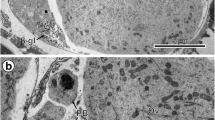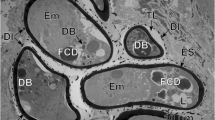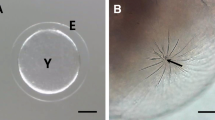Summary
-
1
The egg has about ten micropyles around the forepole. Apart from that the surface is rather smooth, without a pattern, and covered by a wax layer. The chorion is composed of several layers, which are described. It shows adaptations to dry environment. The chorion as a “maternal cuticle” is discussed.
-
2
A vitelline membrane surrounds the oocyte below the chorion. It consists of three laminae: an electron lucent one between two moderately dense ones.
-
3
The serosal cells have presumably a dual function. Strongly developed rough ER and pronounced nucleoli point to the manufacture of proteins, probably enzymes which participate in the liquifaction of the yolk.During development the serosa withdraws from the vitelline membrane and secretes a heterogenous product — a proteinaceous (?) fluid, dense granules and lipid droplets — into the peripheral space. Dense granules are derived from the yolk and transported through the cells without morphological alterations, whereas taken up lipids are apparently metabolized. These processes are interpreted as excretory activities, which shall keep the yolk free of waste substances.
-
4
The same products as in the peripheral space — except for the lipid droplets — are found in the amnion cavity. They are likewise considered as excretory products which are primarily deposited by the germ band cells. The amnion may serve to keep the material in a defined area separate from the nutrition.The appearance of orientated microtubules during katatrepsis may be indicative for an active participation in embryonic movements.
-
5
Pronounced ultrastructural changes occur during transition from ectoderm to epidermis. Ectodermal tissue is characterized by the presence of electron lucent vesicles and free ribosomes. It also secretes the “first embryonic cuticle” (“Cut. I”), a trilaminar membrane which probably represents a cuticulin layer. Besides ectoderm and several ectodermal organ anlagen also the amnion forms this membrane. (Endocrine glands are not yet active.) In this context some aspects of differentiation and determination are discussed.
The embryonic epidermis contains no electron lucent vesicles, but many pigment granules. It secrets two more “embryonic cuticles” (“Cut. II and III”) which have the structure of a typical larval one prior to ecdysis (endocuticle=procuticle). A wax layer, however, is already present. “Cut. III” represents the first larval cuticle.
Similar content being viewed by others
References
Anderson, D.T.: The development of hemimetabolous insects. In: Developmental systems: Insects (S.J. Counce, C.H. Waddington, eds.), Vol. 1, pp. 95–163. London-New York: Academic Press 1972
Beams, H.W., Kessel, R.G.: Synthesis and deposition of oöcyte envelopes (vitelline membrane, chorion) and the uptake of yolk in the dragonfly (Odonata: Aeschnidae). J. Cell. Sci.4, 241–264 (1969)
Bouligand, Y.: Sur une architecture torsadée répandue dans de nombreuses cuticules d'arthropodes. C.R. Acad. Sci., Paris261, 3665–3668 (1965)
Bullière, F.: Cycles embryonnaires et sécrétion de la cuticule chez l'embryon de blatte,Blabera craniifer. J. Insect Physiol.19, 1465–1479 (1973)
Butt, F.H.: Embryology of the milkweed bugOncopeltus fasciatus. Cornell Univ. Agr. Exp. Sta., Mem.283, 1–43 (1949)
Chauvin, G., Barbier, R., Bernard, J.: Ultrastructure de l'oeuf deTriatoma infestans Klug (Heteroptera, Reduviidae), formation des cuticules embryonnaires, rôle des enveloppes dans le transit de l'eau. Z. Zellforsch.138, 113–132 (1973)
Chauvin, G., Rahn, R., Barbier, R.: Comparaison des oeufs des lepidotèresPhalem bucephala L. (Ceruridae),Acrolepia assectella Z. etPlutella maculipennis Curt. (Plutellidae): morphologie et ultrastructures particulières du chorion au contact du support vegetal. Int. J. Insect Morph. Embryol.3, 247–256 (1974)
Cobben, R.R.: Evolutionary trends in Heteroptera- I. Egg. architecture of shell, gross embryology and eclosion. Wageningen (Netherlands): Centre for Agricultural Publication and Documentation 1968
Cruickshank, W.J.: Ultrastructural modifications in the follicle cells and egg membranes during development of flour moth oöcytes. J. Insect Physiol.18, 485–498 (1972)
Cummings, M.R.: Formation of the vitelline membrane and chorion in developing oocytes ofEphestia kühniella. Z. Zellforsch.127, 175–188 (1972)
Cummings, M.R., Brown, N.M., King, R.C.: The cytology of the vitellogenic stages of oogenesis inDrosophila melanogaster. III. Formation of the vitelline membrane. Z. Zellforsch.118, 482–492 (1971)
Dorn, A.: Die endokrinen Drüsen im Embryo vonOncopeltus fasciatus Dallas (Insecta, Heteroptera). Morphogenese, Funktionsaufnahme, Beeinflussung des Gewebewachstums und Beziehungen zu den embryonalen Häutungen. Z. Morph. Tiere71, 52–104 (1972)
Dorn, A.: Struktur und Funktion des embryonalen Corpus allatum vonOncopeltus fasciatus Dallas (Insecta, Heteroptera). Verh. Dtsch. Zool. Ges.67, 85–89 (1975)
Dorn, A.: Review of hormonal control of egg maturation and embryonic development in insects. In press (1976)
Furneaux, P.J.S., James, C.R., Potter, S.A.: The egg shell of the house cricket (Acheta domesticus): an electron-microscope study. J. Cell Sci.5, 227–249 (1969)
Furneaux, P.J.S., Mackay, A.L.: Cristalline protein in the chorion of insect egg shells. J. Ultrastruct. Res.38, 343–359 (1972)
Gerrity, R.C., Rempel, J.G., Sweeny, P.R., Church, N.S.: The embryology ofLytta viridana Le Conte (Coleoptera: Meloidae). II. The structure of the vitelline membrane. Canad. J. Zool.45, 497–503 (1967)
Hartley, J.C.: The structure and function of the egg-shell ofDeraeocoris ruber L. (Heteroptera, Miridae). J. Insect Physiol.11, 103–109 (1965)
Hinton, H.E.: Concealed phases in the metamorphosis on insects. Sci. Progr.182, 262–275 (1958)
Hinton, H.E.: The structure and function of the egg shell in the Nepidae (Hemiptera). J. Insect Physiol.7, 224–257 (1961)
Hinton, H.E.: Respiratory systems of insect egg shells. Ann. Rev. Entomol.14, 343–368 (1969)
Hopkins, C.R., King, P.E.: An electron-microscopical and histochemical study of the oocyte periphery inBombus terrestris during vitellogenesis. J. Cell Sci.1, 201–216 (1966)
Kawasaki, H., Sato, H., Suzuki, M.: Structural proteins in the egg envelopes of the mealworm beetle,Tenebrio molitor. Insect. Biochem.5, 25–34 (1975)
King, R.C., Koch, E.A.: Studies on the ovarian follicle cells ofDrosophila. Quart. J. micr. Sci.104, 297–320 (1963)
Larink, O.: Zur Struktur der Blastodermcuticula vonPetrobius brevistylis undP. maritimus (Thysanura, Insecta). Cytobiologie5, 422–426 (1972)
Locke, M.: The structure and formation of the integument in insects. In: The physiology of Insecta (M Rockstein, ed), 2nd ed., Vol. VI, pp. 123–213. New York-London: Academic Press 1974
De Loof, A.: Synthesis and deposition of oocyte envelopes in the Colorado beetle,Leptinotarsa decemlineata Say. Z. Zellforsch.115, 351–360 (1971)
Louvet, J.-P.: Observation en microscopic électronique des cuticules édifiées par l'embryon, et discussion du concept de ≪mue embryonnaire≫ dans le cas du phasmeCarausius morosus Br. (Insecta, Phasmida). Z. Morph. Tiere78, 159–179 (1974)
McFarlane, J.E.: The cuticle of the egg of the house cricket. Canad. J. Zool.40, 13–21 (1962)
Mori, H.: Normal embryogenesis in the waterstrider,Gems paludum insularis Motschulsky, with special reference to midgut formation. Jap. J. Zool.16, 53–67 (1969)
Mori, H.: The distribution of the columnar serosa of eggs among the families of Heteroptera, in relation to phylogeny and systematics. Jap. J. Zool.16, 89–98 (1970)
Mori, H.: Water absorption by the columnar serosa in the eggs of the waterstrider,Gerris paludum insularis. J. Insect Physiol.18, 675–681 (1972)
Okada, E., Waddington, C.H.: The submicroscopic structure of theDrosophila egg. J. Embryol. exp. Morph.7, 583–597 (1959)
Quattropani, S., Anderson, E.: The origin and structure of the secondary coat of the egg ofDrosophila melanogaster. Z. Zellforsch.95, 495–510 (1969)
Shields, G., Dübendorfer, A., Sang, J. H.: Differentiation in vitro of larval cell types from early embryonic cells ofDrosophila melanogaster. J. Embryol. exp. Morph.33, 159–175 (1975)
Slifer, E.H.: The formation and structure of a special water absorbing area in the membranes covering the grasshopper egg. Quart J. micr. Sci.80, 43–57 (1938)
Slifer, E.H., Sekhon, S.S.: The fine structure of the membranes which cover the egg of the grasshopper,Melanoplus differentialis, with special reference to the hydropyle. Quart. J. micr. Sci.104, 321–334 (1963)
Smith, D.S., Telfer, W.H., Neville, A.C.: Fine structure of the chorion of a moth,Hyalophom cecropia. Tissue and Cell3, 477–498 (1971)
Striebel, H.: Zur Embryonalentwicklung der Termiten. Acta trop. (Basel)17, 193–260 (1960)
Sweeny, P.R., Church, N.S., Rempel, J.G., Gerrity, R.G.: The embryology ofLytta viridana Le Conte (Coleoptera: Meloidae). III. The structure of the chorion and micropyles. Canad J. Zool.46, 213–217 (1968)
Telfer, W.H., Smith, D.S.: Aspects of egg formation. In: Insect ultrastructure (A.C. Neville, ed.), Roy. Ent. Soc. Sympos., Vol. 5, pp. 117–134. Oxford: Blackwell 1970
Weber, H.: Lehrbuch der Entomologie. Stuttgart: Fischer 1933
Weber, H.: Grundruß der Insektenkunde, 3. Aufl. Stuttgart: Fischer 1954
Author information
Authors and Affiliations
Additional information
Supported by the Deutsche Forschungsgemeinschaft
I am indebted to Miss I. von Graevenitz and Mrs. M. Ullmann for excellent technical assistance.
I thank Mr. J. Tochtenhagen, who took the scanning electron micrographs
Rights and permissions
About this article
Cite this article
Dorn, A. Ultrastructure of embryonic envelopes and integument ofOncopeltus fasciatus Dallas (Insecta, Heteroptera). Zoomorphologie 85, 111–131 (1976). https://doi.org/10.1007/BF00995407
Received:
Issue Date:
DOI: https://doi.org/10.1007/BF00995407




